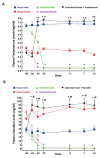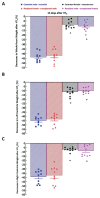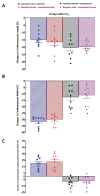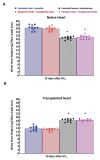Sex-Linked Differences in Cardiac Atrophy After Heterotopic Heart Transplantation: No Direct Relation to the Actions of Sex Steroid Hormones
- PMID: 39589301
- PMCID: PMC11627268
- DOI: 10.33549/physiolres.935308
Sex-Linked Differences in Cardiac Atrophy After Heterotopic Heart Transplantation: No Direct Relation to the Actions of Sex Steroid Hormones
Abstract
An important complication of prolonged support of the left ventricle with an assist device when implanted in patients with heart failure is unloading-induced cardiac atrophy. Our recent study suggested that sex-linked differences in the development of atrophy induced by heterotopic heart transplantation (HTX) do exist, however, the role of the environmental conditions dependent on plasma concentrations of sex hormones remains elusive. We aimed to compare the course of HTX-induced cardiac atrophy in male and female rats after gonadectomy with substitution of steroid hormones of the opposite sex. In a separate series of experiments, we evaluated the course of unloading-induced cardiac atrophy in the female heart transplanted into a male recipient and vice versa. Cardiac atrophy was assessed as the ratio of the transplanted heart weight to native heart weight (HW), which was determined 14 days after HTX. In female rats, studied in both experimental variants, HTx resulted in significantly smaller decreases in whole HW when compared to those observed in male rats exposed to the same experimental conditions (-9 ± 1 and - 11 + 1 vs. -44 ± 2 and -42 ± 2 %, p?0.05 in both cases). The dynamic of changes in left and right ventricle was similar as in the whole HW. Our results show that the process of unloading-induced cardiac atrophy exhibits important sex-linked differences and that attenuation of this process in female rats cannot be simply ascribed to the protective effects of estradiol or to the absence of deleterious actions of testosterone. Keywords: Cardiac atrophy, Sex differences, Gonadectomy, Hormonal substitution, Heterotopic heart transplantation, Mechanical heart unloading.
Conflict of interest statement
Figures







Similar articles
-
Intraventricular spring expander attenuates cardiac atrophy of the failing heart after unloading caused by heterotopic heart transplantation: no sex-linked differences.Physiol Res. 2025 Jul 23;74(3):373-392. Physiol Res. 2025. PMID: 40698656
-
Sex-Linked Differences in Cardiac Atrophy After Mechanical Unloading Induced by Heterotopic Heart Transplantation.Physiol Res. 2024 Mar 11;73(1):9-25. doi: 10.33549/physiolres.935217. Physiol Res. 2024. PMID: 38466001 Free PMC article.
-
Isovolumic loading of the failing heart by intraventricular placement of a spring expander attenuates cardiac atrophy after heterotopic heart transplantation.Biosci Rep. 2018 Jun 27;38(3):BSR20180371. doi: 10.1042/BSR20180371. Print 2018 Jun 29. Biosci Rep. 2018. PMID: 29743195 Free PMC article.
-
Impact of sex in the prevalence and progression of glioblastomas: the role of gonadal steroid hormones.Biol Sex Differ. 2021 Mar 22;12(1):28. doi: 10.1186/s13293-021-00372-5. Biol Sex Differ. 2021. PMID: 33752729 Free PMC article. Review.
-
Activational and organisational effects of gonadal steroids on sex-specific acetylcholine release in the dorsal hippocampus.J Neuroendocrinol. 2009 Mar;21(4):400-5. doi: 10.1111/j.1365-2826.2009.01848.x. J Neuroendocrinol. 2009. PMID: 19356199 Review.
